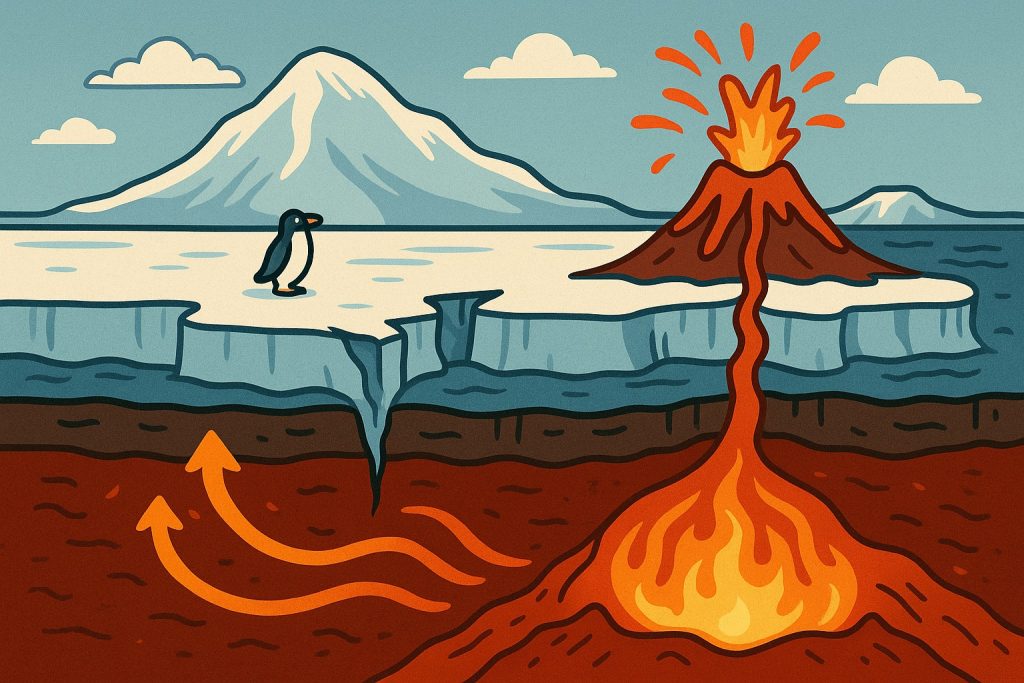While most discussions about Antarctica’s melting focus on rising air temperatures and shrinking glaciers, a less visible but equally critical process is unfolding beneath the ice: geothermal heating. Over the past three decades, scientists have increasingly found evidence that Antarctica is warming from below, a process that could accelerate ice loss and destabilize the entire ice sheet.
What Is Subglacial Warming?
Subglacial warming refers to the heating of ice from beneath due to a combination of:
- Geothermal heat rising from Earth’s mantle
- Friction generated by the movement of ice over rock
- Volcanic activity, especially in West Antarctica
This heat melts the base of the ice sheet, creating subglacial lakes and rivers that can lubricate ice flow, making glaciers slide more easily into the sea.
Key Discoveries Since the 1990s
- Satellite and radar mapping have revealed hidden subglacial lakes, such as Lake Vostok and Lake Whillans—liquid bodies under kilometers of ice.
- In West Antarctica (check Mary Bird lastest NASA research), especially beneath the Thwaites and Pine Island glaciers, scientists detected unusually high geothermal flux, suggesting active geological processes.
- The Antarctic Impulsive Transient Antenna (ANITA) and NASA missions like Operation IceBridge have contributed to a detailed 3D mapping of the bedrock and heat sources.
- A 2018 study using ice-penetrating radar confirmed that heat from Earth’s interior is stronger than expected beneath parts of the West Antarctic Ice Sheet.
What Causes the Heat?
- The West Antarctic Rift System is a geologically active zone, with numerous volcanoes (some active or dormant) emitting geothermal energy.
- Tectonic thinning of Earth’s crust in this region allows more heat to escape from the mantle.
- In some areas, magma reservoirs exist just a few kilometers beneath the ice.
Why Does It Matter?
The impact of subglacial heating is significant:
- Accelerated ice flow: Meltwater at the base reduces friction, causing glaciers to speed up and deposit more ice into the ocean.
- Sea-level rise: West Antarctica alone holds enough ice to raise global sea levels by over 3 meters.
- Ice shelf instability: Subglacial melt can weaken the base of floating ice shelves, leading to cracks and break-ups.
- Feedback loops: As ice thins, more geothermal heat escapes, which further melts the ice—a vicious cycle.
The Future: What Could Happen?
If subglacial heating continues or intensifies:
- Ice loss from West Antarctica may become irreversible.
- Coastal cities worldwide could face more frequent flooding from sea-level rise.
- Changes in Antarctic ice could disrupt ocean currents and weather systems globally.
This highlights the urgent need for more monitoring, international cooperation, and stronger climate action.
Glossary
- Geothermal heat — Heat originating from within the Earth, especially from the mantle.
- Subglacial lake — A body of liquid water trapped beneath an ice sheet.
- Thwaites Glacier — A major glacier in West Antarctica, often called the “Doomsday Glacier” due to its potential to raise sea levels significantly.
- Geothermal flux — The rate at which heat flows from Earth’s interior to the surface.
- Rift system — A zone where the Earth’s crust is pulling apart, allowing magma and heat to rise.
- Ice shelf — A floating extension of an ice sheet that is connected to land-based ice.


